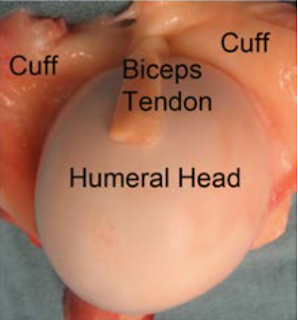These authors performed MRI's on 20 men and 7 women with acute ruptures of the proximal biceps tendon. The dominant side was involved in 20 injuries (74%), and a low-energy trauma mechanism of injury was involved in 23 (85%). Of the patients, 11 (41%) reported a history of antecedent shoulder pain.
Magnetic resonance imaging assessment revealed that 93% of patients had evidence of rotator cuff disease, including 13 full-thickness tears. Of the full-thickness tears, 3 were small, 6 medium, 2 large, and 2 massive. Pathology of the subscapularis tendon was identified in 7 patients (26%).
Comment: Patients with rupture of the long head of the biceps are likely to have rotator cuff defects; patients with cuff defects are likely to have involvement of the long head of the biceps tendon. This association is not surprising for several reasons:
(1) both cuff defects and biceps ruptures usually result from age-related degeneration of tendon quality
(2) the cuff and the long head of the biceps are physically proximal to each other, both contributing to the stability of the shoulder through concavity compression; thus compromise of one is likely to increase the load experienced by the other.
A normal shoulder:
A shoulder with a rotator cuff tear and a degenerating biceps tendon
A few things to keep in mind:
Shoulders with impending biceps tendon rupture may demonstrate pain on active elevation that disappears once the rupture of the biceps tendon is complete.
It is not possible to restore the normal shoulder function of the long head biceps tendon once it is ruptured. A biceps tenodesis simply stabilizes the ruptured long head to the humerus after the tendon has left the shoulder.
Many patients with ruptures of the long head of the biceps tendon become functional and minimally symptomatic without surgery.
A normal shoulder:
A shoulder with a rotator cuff tear and a degenerating biceps tendon
Shoulders with impending biceps tendon rupture may demonstrate pain on active elevation that disappears once the rupture of the biceps tendon is complete.
It is not possible to restore the normal shoulder function of the long head biceps tendon once it is ruptured. A biceps tenodesis simply stabilizes the ruptured long head to the humerus after the tendon has left the shoulder.
Many patients with ruptures of the long head of the biceps tendon become functional and minimally symptomatic without surgery.
=====
The reader may also be interested in these posts:
Use the "Search" box to the right to find other topics of interest to you.
You may be interested in some of our most visited web pages including:shoulder arthritis, total shoulder, ream and run, reverse total shoulder, CTA arthroplasty, and rotator cuff surgery as well as the 'ream and run essentials'


